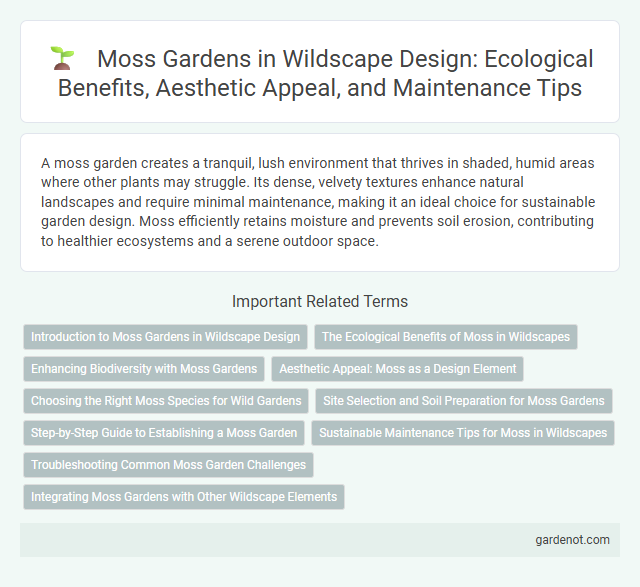A moss garden creates a tranquil, lush environment that thrives in shaded, humid areas where other plants may struggle. Its dense, velvety textures enhance natural landscapes and require minimal maintenance, making it an ideal choice for sustainable garden design. Moss efficiently retains moisture and prevents soil erosion, contributing to healthier ecosystems and a serene outdoor space.
Introduction to Moss Gardens in Wildscape Design
Moss gardens in Wildscape design offer a unique way to create lush, low-maintenance green spaces that enhance biodiversity and support native wildlife. These gardens utilize shade-tolerant moss species that thrive in natural, moist environments, promoting soil health and erosion control. Integrating moss gardens into Wildscape landscapes provides aesthetic appeal while fostering sustainable ecological balance.
The Ecological Benefits of Moss in Wildscapes
Moss gardens in wildscapes play a crucial role in enhancing biodiversity by creating microhabitats for numerous invertebrates and microorganisms. Their ability to retain moisture helps regulate soil humidity, reducing erosion and promoting healthier plant growth. Moss also acts as a natural air filter, absorbing pollutants and improving overall air quality in these ecosystems.
Enhancing Biodiversity with Moss Gardens
Moss gardens play a crucial role in enhancing biodiversity by providing habitat for numerous microfauna and supporting crucial ecological processes such as moisture retention and nutrient cycling. These gardens create microclimates that sustain rare and endemic species, promoting a balanced ecosystem within wildscapes. Integrating moss gardens into green spaces increases ecological resilience and encourages a diverse array of flora and fauna, fostering sustainable biodiversity.
Aesthetic Appeal: Moss as a Design Element
Moss gardens create a serene aesthetic appeal by adding lush, velvety textures and vibrant green hues that enhance natural landscapes. This minimalist design element thrives in shaded, moist environments, offering a soft, tranquil ground cover that complements stone pathways and wooden structures. Integrating moss into wildscapes emphasizes harmony and subtle beauty, elevating the garden's visual and sensory experience.
Choosing the Right Moss Species for Wild Gardens
Selecting the right moss species for wild gardens requires understanding local climate, soil moisture, and light conditions to ensure healthy growth. Popular moss varieties such as Dicranum scoparium, Hypnum cupressiforme, and Polytrichum commune offer diverse textures and adaptability for naturalistic landscapes. Proper species selection enhances biodiversity, promotes soil retention, and creates lush green carpets that thrive with minimal maintenance.
Site Selection and Soil Preparation for Moss Gardens
Choosing a shaded, humid site with stable moisture levels is essential for moss garden success, as moss thrives in low-light environments with minimal direct sunlight. Soil preparation involves removing existing vegetation, loosening the surface to enhance drainage, and ensuring an acidic pH between 5.0 and 6.0, which promotes healthier moss growth. Incorporating organic matter like leaf mold improves soil texture and moisture retention, creating ideal conditions for moss establishment and sustainability.
Step-by-Step Guide to Establishing a Moss Garden
Creating a moss garden involves selecting a shaded, moist area with acidic soil pH between 5.0 and 6.0 to promote moss growth. Begin by clearing the site of debris and weeds, then gently press moss fragments collected from similar environments onto the prepared surface to ensure proper contact. Maintain consistent moisture through regular misting and prevent direct sunlight to encourage healthy establishment and vibrant moss coverage.
Sustainable Maintenance Tips for Moss in Wildscapes
Sustainable maintenance of moss in wildscapes involves minimizing water usage by misting moss during dry spells and avoiding excessive irrigation that can disrupt its natural balance. Regularly removing debris and invasive species ensures the moss receives adequate light and nutrients essential for healthy growth. Employing organic fertilizers and avoiding chemical herbicides preserves the delicate ecosystem and promotes a thriving, low-impact moss garden.
Troubleshooting Common Moss Garden Challenges
Moss gardens often face challenges such as patchy growth caused by insufficient moisture or improper light conditions. Ensuring consistent humidity and providing shaded areas can help prevent moss from drying out or becoming scorched. Regularly removing debris and controlling competing plants promotes healthy moss establishment and vibrant green coverage.
Integrating Moss Gardens with Other Wildscape Elements
Moss gardens seamlessly integrate with wildscape elements by enhancing biodiversity and improving soil moisture retention. Combining moss with native wildflowers, ferns, and natural stone creates a harmonious, low-maintenance ecosystem that supports local wildlife. Utilizing moss as ground cover alongside native shrubs and water features intensifies habitat complexity and promotes ecological balance.
Moss garden Infographic

 gardenot.com
gardenot.com